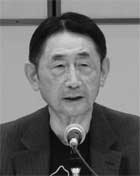| 【特集】第32回定例シンポジウム「『歴史戦』をどう闘うか」 |
| 《基調講演》 |
悪魔でさえも描かれるほど黒くはない
“Even the Devil is not so black as he is painted.” |
東京大学名誉教授 平川祐弘
HIRAKAWA, Sukehiro Professor Emeritus, University of Tokyo
|
 本日は過去の戦争をどう考えるか、について私見を述べさせていただく。しかし私一人が一方的に壇上から歴史解釈を述べるより、会場の皆さまにも対話に参加していただく方が意味があろうかと思い、お手許に皆さまの歴史理解をお尋ねする紙もお配りする。これからの私の基調講演の中で質問をまじえるから、その際は解答欄に〇か×をつけてくださるようお願いする。後で回収させていただく。お名前を書く、書かないは皆さまの自由である。 本日は過去の戦争をどう考えるか、について私見を述べさせていただく。しかし私一人が一方的に壇上から歴史解釈を述べるより、会場の皆さまにも対話に参加していただく方が意味があろうかと思い、お手許に皆さまの歴史理解をお尋ねする紙もお配りする。これからの私の基調講演の中で質問をまじえるから、その際は解答欄に〇か×をつけてくださるようお願いする。後で回収させていただく。お名前を書く、書かないは皆さまの自由である。
アメリカの日本理解はどの程度のものであるのか
アメリカをはじめ外国の日本理解は少しずつ進んだ。 ペリー来航の 1853 年より80年後の満州事変の昭和日本にはグルー大使が来日した。 1945年には敵味方の飛行機が撃沈され、東京が焼かれるのを私は見た。第二次大戦後の私は平和の海であるべき Pacific Ocean 太平洋を挟んだ両国がいかにして戦争に突入したか、いかにしてまた戦いの海が平和の海に戻ったか、その過程や原因が知りたくて関係者の本をむさぼり読んだ。その中で Joseph Grew, Ten Years in Japan
グルー『滞日十年』と『鈴木貫太郎自伝』が一番印象に残っている。そして米国には知日派の立派な人がいると敬意を抱いた。*1
それから更に80年が経った。今はアメリカからはケネディー大使が来日しているが、米国の日本理解は更に進んでいる筈とお考えであろう。しかしその日本理解の程度はどのようなものか。アメリカ人にもさまざまな人がいることを私どもは知らねばならない。外国の日本研究者の質が劣化することはいくらでもあり得る。
第一問 2015年のアメリカの日本理解の実情の一例
それでは今日のアメリカの日本歴史を研究する人たちは日本ならびに日本史についてどの程度の理解をもっているか。初めの文章はアメリカの大手の出版社の歴史教科書の「慰安婦」の部分の一部である。
慰安婦。戦争における体験は女性を力づける高貴なものばかりとは限らない。日本軍は年齢14歳から20歳にいたる
20万人の女を強制的に徴用し、銃剣を突きつけて慰安所と呼ばれる軍隊用の女郎屋で無理矢理に働かせた。日本軍は
部隊に女たちを「天皇陛下からの贈物」として提供した。女たちは日本の植民地の朝鮮、台湾、満洲やフィリピンその他
の東南アジアの日本軍占領地から連れてこられたが、大部分は朝鮮・中国出身者である。
ひとたび日本帝国のプロスティチューション・サービスの中に組み込まれると、慰安婦は1日に20人から30人の男をとら
ねばならぬ。戦地にいた場合は兵隊と同じ危険に遭遇した。逃げようとした者、また性病に罹った者は日本兵によって殺
された。敗戦の際にこの件を隠すために日本兵は多数の慰安婦を虐殺した。
執筆者はジーグラーHerbert Ziegler、ハワイ大学の准教授である。「これが本当にアメリカの歴史教科書か」と本席においでの皆さまは呆れるであろう、この内容は事実に立脚するよりも sexual fantasy という感じがする。しかし彼ら執筆者の側に言わせれば、こうしたことは家永三郎『太平洋戦争』(岩波書店)にも出ている(因みに同書は吉田清治『私の戦争犯罪 朝鮮人強制連行』に依拠している)と答えて変更を拒否するであろう。或いはこれは日本の歴史学者吉見義明中央大学教授の調査に依拠していると言うであろう。
この教科書を読んで河野洋平元官房長官はなんと言うであろうか。
吉見義明氏自身はなんと言うであろうか。
*1 それだから私は Sukehiro Hirakawa, Japan’s Love-Hate Relationship with the West (Global Oriental)や『平和の海と戦いの海』でグルーと斎藤實夫妻や鈴木貫太郎について書いたのである。
-------------------------------------------------------------------------------------------------------------------------------------------------------
Today I am going to offer my own views on the past war. But instead of my unilaterally speaking from the podium on matters of his torical interpretation, I think it might be more meaningful to have everyone in the audience engage in a conversation with me. Near your seats, you should find a quiz that will test your understanding of history. In my keynote speech to follow, I am going to intersperse some questions. Whenever I ask a question, please mark either “True” or “False” next to the corresponding question on your quiz. When my speech is done, we will collect the quizzes. You may write your names on your papers, or you may choose to remain anonymous.
How Well doAmericans Understand Japan?
Americans, and foreigners in general, have gradually come to understand more about Japan. Ambassador Joseph Grew came to Japan in 1932, during the time of the Manchu-rian Incident. It was eighty years after the arrival of Commodore Matthew Perry’s Black Ships in 1853. As a young boy, I saw many American and Japanese planes shot down and I saw the city of Tokyo in fire by indiscriminate bombings. After the war, I devoured books written by those who had been involved in the war in some way. I wanted to know about the causes and process of that war. How did Japan and the United States enter into a war across the Pacific Ocean, which, as its name implies, was supposed to be a sea of great peace? And how did that ocean of fighting go back to being a peaceful ocean again? Of all the books I read, the two that made the greatest impression upon me were Joseph Grew’s Ten Years in Japan, and Suzuki Kantarō’s Autobiography.*1 I came to respect the fact that there were great Americans who knew Japan well. It happens that the guality of Japan scholars deteriorates with the passage of time.
Now, eighty more years have gone by. Caroline Kennedy is now the American ambassador to Japan. One would think that the American understanding of Japan might have progressed even further since the time of Ambassador Grew. But how does that understanding really measure up? We must also understand that there are all sorts of people among the Americans.
Question One : An example illustrating the state of American understanding of Japan in 2015
How well do Americans who today are engaged in the research of Japanese history re ally understand Japan and her history? The following passage is from the “Comfort Women” section of a history textbook published by a major American publishing company:
Comfort Women
Women’s experiences in war were not always ennobling or empowering. The Japanese army forcibly recruited, conscripted, and dragooned as many as two hundred thousand women age fourteen to twenty to serve in military brothels, called “comfort houses” or “consola tion centers.” The army presented the women to the troops as a gift from the emperor, and the women came from Japanese colonies such as Korea, Taiwan, and Manchuria and from occupied territories in the Philippines and elsewhere in southeast Asia. The majority of the women came from Korea and China.
Once forced into this imperial prostitution service, the “comfort women” catered to between twenty and thirty men each day. Stationed in war zones, the women often confronted the same risks as soldiers, and many became casualties of war. Others were killed by Japanese soldiers, especially if they tried to escape or contracted venereal diseases. At the end of the war, soldiers massacred large numbers of comfort women to cover up the operation.
The author of this passage is Herbert Ziegler, an associate professor at the University of Hawai’i. You are probably astonished that this could possibly be in a history textbook in the United States. The passage quoted above, far from being rooted in facts, has more of the feeling of sexual fantasy. But I am sure that the writers would refuse to change what they had written, arguing that such information appears in Ienaga Saburō’s The Pacific War [Iwanami Shoten]. (Ienaga, by the way, relies on Yoshida Seiji, My War Crimes, Forced Transport of Koreans.) Ziegler, et al., may also argue, in their defense, that this information is based on surveys carried out by Japanese historian Yoshimi Yoshiaki (Chūō University).
If he were to read this textbook, what would former Chief Cabinet Secretary Kōno Yōhei have to say? What would Prof. Yoshimi himself say?
*1 It was for this reason that I wrote a paper on the relationship between Ambassador Grew and Premier Suzuki Kantarō in Sukehiro Hirakawa, Japan’s Love-Hate Relationship with the West (Global Oriental) pp. 283-306.
|
続きをご覧になりたい方は...
|
|